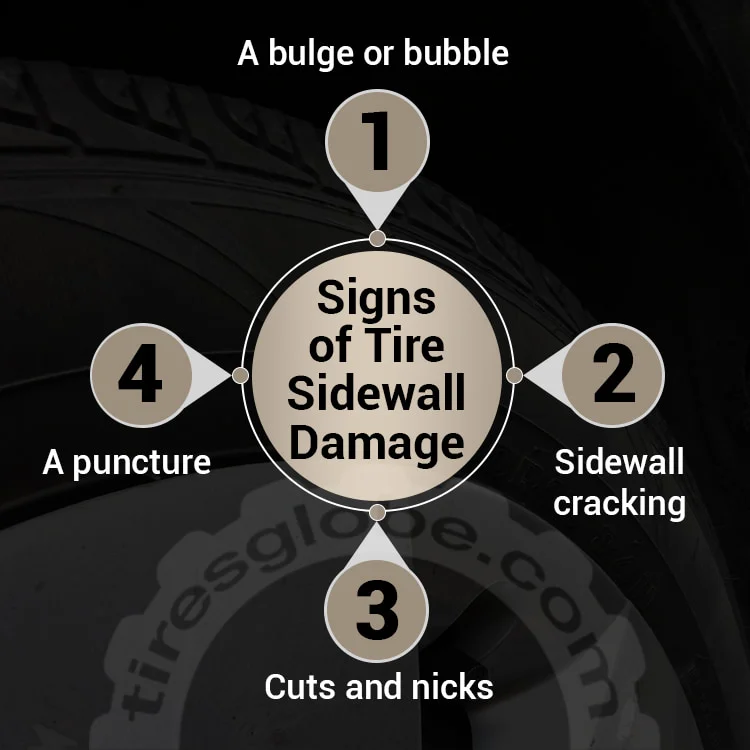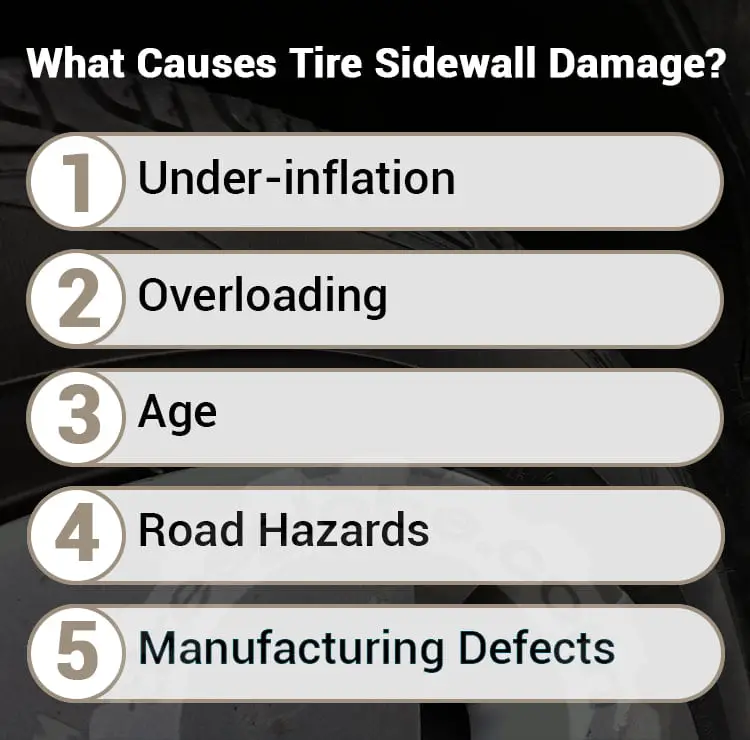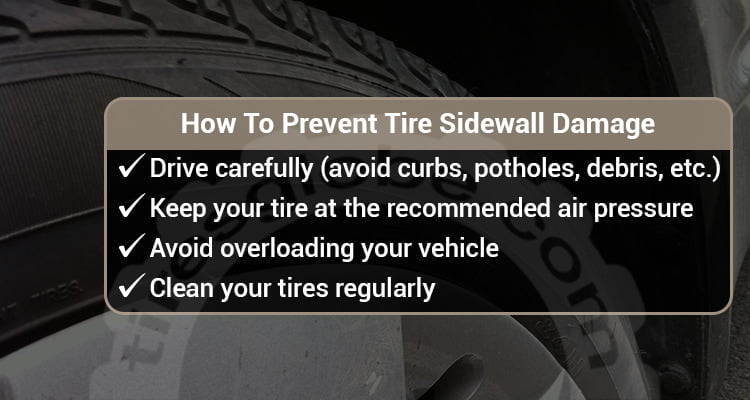Do you wonder what the signs and causes of tire sidewall damage are? Do you have this question “how much tire sidewall damage is too much” in mind and want an exact answer for it?
If yes, then you’ve come to the right place!
We have covered everything you need to know about your tire’s sidewall damage in this article. Also, you will be provided with some tips on how to prevent it.
Keep reading on!
How To Check Tire Sidewall Damage
Let’s start with a question; what is tire sidewall damage? As the name “sidewall” implies, it refers to any damage on the side of your tire. If you notice damage on your tire’s sidewall, it must be taken care of ASAP. Why? Because the complications that may arise from driving on a tire with a damaged sidewall can be catastrophic.
With this in mind, it would help if you knew how to check your tire for sidewall damage. We’ve got you covered. Below we have compiled the signs of tire sidewall damage:

- A bulge or bubble on the sidewall
- Tire sidewall cracking
- A puncture
- Cuts and nicks on the sidewall
Overall, any visible sign of wear on your tire’s sidewall points towards sidewall damage.
What Causes Tire Sidewall Damage
Although the sidewall of a tire is tough and rigid, there are several factors that can damage it:

Under-inflation
When your tire is under-inflated, its sidewall will flex more and more. It is because the pressure required to support the vehicle’s load isn’t enough. Therefore, this will cause the tire to overheat, damaging the sidewall in the process.
Overloading
Carrying a load that exceeds your tire load rating is never a great idea. Overloading your tire means more friction with the ground, implying that your tires will overheat. Too much heat could cause cracks on the sidewall. Also, overloading can cause a sidewall tire blow-out.
Age
Like all products, tires have an expiry date. Tire companies say that a tire is safe for use for the first 6 – 10 years, starting from its manufacturing date. After this given time, the tire rubber (including sidewall) begins to lose its integrity as it deteriorates when exposed to heat and oxygen.
Subsequently, the rubber’s flexibility will reduce because it becomes brittle and easily susceptible to damage. As a result, you may begin to notice cracks on the tire’s sidewall, which is a pointer that the tire is due for a change.
Road Hazards
Road hazards are another major cause of sidewall damage. What are these road hazards? They include debris, potholes, curbs, etc. These hazards can puncture or cut the sidewall of your tire. This implies that you should keep an eye out for the road hazards when driving.
Manufacturing Defects
We’ve all unknowingly bought a defective product at some point. The primary manufacturing defect that could cause tire sidewall damage is an inadequate speed rating.
How? Insufficient testing before the release of the tire into the market can leave it with a much lower speed rating. Exceeding the speed rating of a tire will damage its sidewall or worse (tire sidewall blow-out).
In general, the above points aren’t the only causes of tire sidewall damage. Other causes of tire sidewall damage include poor driving and cases of vandalism.
In general, the above points are the major reasons for tire sidewall damage. However, there are also other causes of tire sidewall damage including poor driving and cases of vandalism.
How Much Tire Sidewall Damage Is Too Much?
This is the single most crucial question. Before we get into the details, I must say; if the threads in the sidewall damage of a tire are visible, it means that tire is due for change. That’s a rule of thumb.
You can find the threads 3 mm – 4.5 mm deep into your tire. Also, when the sidewall damage is too much, you notice an air bubble on it. This air bubble is a pointer that it might blow pretty soon. If it comes to this, you should take the tire to a repair store so that an expert can have a look at it. Either way, we recommend replacing such a tire instead of trying to fix it.
Is It Safe To Drive On A Tire With Sidewall Damage?
No, it is not safe. In fact, it is illegal to drive on a tire with sidewall damage as it puts the general safety of the public at risk. The sidewall of a tire may be tough and rigid; but it isn’t as strong as the tread area.
However, there are levels to tire sidewall damage. If you have a really shallow scratch on your tire’s sidewall, it won’t be too much of a problem so long as it doesn’t reach the threads. As for our advice, we recommend that you take that tire to be examined by an expert.
Can Tire Sidewall Damage Be Repaired?
Whether or not you can repair a tire sidewall damage heavily depends on the severity of the injury. As we mentioned earlier, you shouldn’t bother trying to repair tire sidewall damage if its threads are visible. Instead, you should replace the tire completely. Why? Because the structure and integrity of the tire have already been compromised. Additionally, big punctures and bubbles on the sidewall shouldn’t be fixed either.
However, if the cut is very shallow, there isn’t any point in fixing the tire’s sidewall because it wouldn’t need repairing.
How To Prevent Tire Sidewall Damage
Why bother to repair tire sidewall damage when you can prevent it? It seems like a much more efficient way of maintaining your tire. Knowing how to prevent tire sidewall damage will not only save you a lot of trouble, it will also save you lots of money. Thankfully, we have provided you with some tips on how to prevent tire sidewall damage.

- Drive carefully (avoid curbs, potholes, debris, etc.)
- Keep your tire at the recommended air pressure
- Avoid overloading your vehicle
- Clean your tires regularly
All these tips point towards one thing: proper tire maintenance. If you consciously implement these tips, the chances of having tire sidewall damage fall to near zero percent. We understand that accidents might happen, and that’s why we can’t say you have a zero percent chance of having tire sidewall damage.
Conclusion
Amongst other tire problems, damage to the tire sidewall is one that you should not take lightly. Thanks to this article, we are confident that you wouldn’t be driving on a tire with bubbles on its sidewall. Remember that the safety of yours and others should be a top priority when driving. By implication, this means that the moment you notice any of the signs of tire sidewall damage, it’s time to visit the garage.
Read more: Tire Wire Showing: How Long To Drive & How To Fix?
